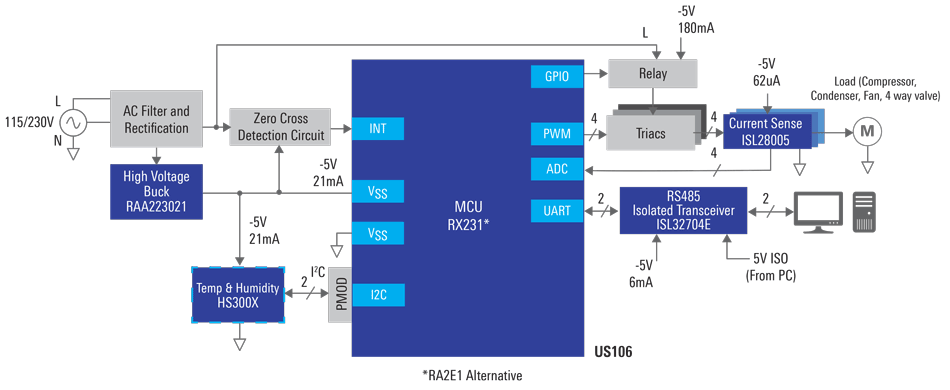The need for portable, small-scale motor applications has been growing in the consumer sector, particularly in portable air conditioning units targeting residential housing, RVs and mobile housing, as the coronavirus pandemic created a surge in RV sales as consumers turned to alternative solutions to traditional holidays.
To address the growing demand and assist engineers in accelerating their design and reducing their time-to-market, this winning combination was designed for TRIAC-based motor control applications. TRIACs (or triode AC switches) are electronic components capable of bidirectional switching and can withstand high voltages and current levels which makes them ideal for AC power control applications such as motor control, light dimmers for domestic lighting, and electronic switches.
In this winning combination, either of the 32-bit RX and RA microcontroller families can be used as the base of the design for controlling the TRIAC switching. The block diagram is shown below in Figure 1. The AC input signal, filtered and rectified, is processed through the RAA223021. This is a 700V high-voltage buck with ultra-low standby power that provides power to the system devices. The filtered AC also passes through a relay that the MCU controls to provide extra protection of the control circuits. If the device does not continuously pulse the relay, it shuts off, and power will not be able to pass through the TRIAC to the load. Due to the flexibility and simplicity of TRIACs and TRIAC control, multiple TRIACs can be connected to multiple loads in this system for increased functionality.
The MCU uses pulse-width modulation (PWM) signals to turn on the TRIACs with high precision, which allows AC current to flow through the TRIACs to the load(s). ISL28005 current sense amplifiers are also used on each TRIAC line to monitor current flow for additional protection. For further added protection and monitoring, sensors such as the HS3001 temperature and humidity sensor can be optionally included to provide feedback to the system. The ISL32704E isolated RS-485 transceiver is included in this design to allow interaction from the user, which can be used for adjusting control signals from the MCU to the system.

The core of this design lies in the use of zero-cross detection to control the PWM signals to the TRIACs. As the AC signal switches from positive to negative, or negative to positive, it will cross through zero volts, which is referred to as the zero crossing, and the MCU uses this information to adjust the duty of the TRIACS. By combining this zero-cross detection circuit with the use of TRIACs, we can easily design and create a solution for motor control, which efficiently drives a motor with sensing feedback, and monitors the power rails, and allows user input to achieve further flexibility and reliability.
Visit the Renesas Winning Combinations page to see more solutions that help our customers to accelerate their designs to get to market faster.
